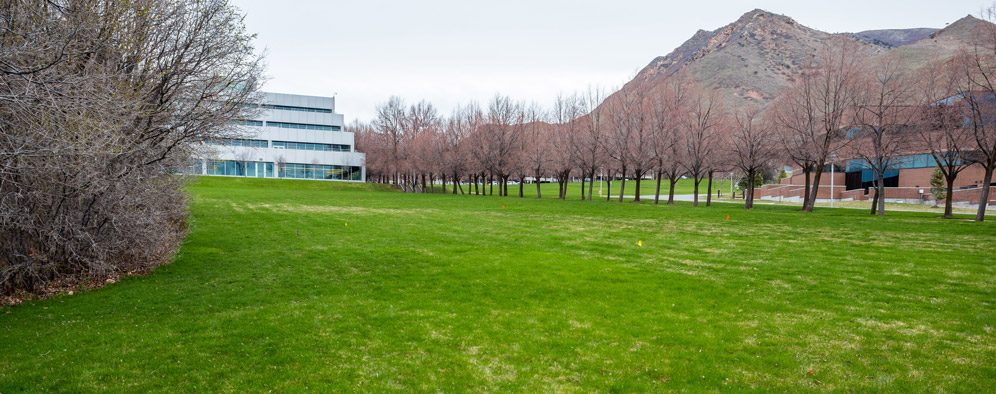
By: Liz Ivkovich, Global Change & Sustainability Center.
Last week, 30 officials from city, county, and state agencies boarded a university shuttle on a tour of campus stormwater infrastructure. For participants, these projects offer a vision for what is possible when it comes to protecting the Jordan River watershed we all share.
Central to the tour was the announcement of $300,000 in new funding awarded to the Center for Ecological Planning & Design by the Utah Division of Water Quality. This grant will be matched with support from University Real Estate Administration to create the new Landscape Lab at the Williams Building.

PHOTO CREDIT: University of Utah
30 officials from the city, county, and state agencies attended a tour at the University of Utah campus.
The Landscape Lab’s goal is to demonstrate sound stormwater management practices. It will transform a one-acre area of water-intensive turfgrass south of the Williams Building into a picturesque, walkable space featuring local plants that reduce irrigation demand. The Williams Building is adjacent to Red Butte Creek, a tributary of the Jordan River.
All stormwater in Salt Lake City ultimately ends up in the Jordan River. Keeping stormwater on-site will not only protect the Jordan River from pollutants and flooding, it will significantly reduce irrigation costs for the Williams Building.
Sarah Hinners, director of the Center for Ecological Planning & Design, intends for the lab to test how well different types of stormwater management features work in our Northern Utah climate.
“Part of what makes this project unique is the multidisciplinary team of soil, plant, and planning experts and engineers involved in it,” said Hinners. “We are able to engage faculty expertise to monitor and share information about best practices with the rest of the Wasatch front.” Dr. Hinner’s team of interested stakeholders also includes University Facilities and Operations staff, who oversee the design, construction, maintenance, environmental permitting and compliance of all stormwater on campus.
The lab will re-direct the water runoff from the Williams Building to its beautiful living plant communities. This allows the plant roots and microbial communities to take up pollutants and filter water through the soil to recharge the groundwater.
The grant received from the Utah Division of Water Quality is being matched with funds from University Real Estate Administration.
“Research Park and Real Estate Administration are excited to be involved in the new Landscape Lab at the Williams Building,” said Jonathan Bates, executive director of Real Estate Administration. “This opportunity to embrace research resulting in the direct implementation of sustainable water use techniques in a business park setting go to the core of the mission of Research Park. As the Park celebrates its 50th birthday we look forward to the opportunity to update our design standards to include concepts that come out of this exciting research initiative. Additionally, we look forward to future opportunities to blend research initiatives with commercial real estate development in order to show the financial, environmental and community benefits of sustainable design.”
In addition to the site of the Landscape Lab, the group also toured several existing low-impact development (LID) stormwater features on campus, including planned retrofits on the HPER mall, some updated permeable pavement at the Natural History Museum of Utah, and the tiered bioswales and rain gardens near USTAR.
The all-day, valley-wide tour was initiated by the Jordan River Commission, an intergovernmental agency tasked with stewarding the Jordan River watershed and implementing the vision for the Jordan River Parkway.
According to Soren Simonsen, executive director of the Jordan River Commission, stormwater projects such as the Landscape Lab are increasingly important in northern Utah.
“The past century and a half of industrialization and urbanization in Salt Lake and Utah valleys have not always been kind to the Jordan River, ” said Simonsen. “We are confident that what we have learned about our ecosystem through science and application in more recent years will allow us to actually improve the Jordan River watershed as the region continues to grow. It will take a concerted effort, and we are excited to have incredible partners like the University of Utah to demonstrate innovative ways of retrofitting our landscapes and green infrastructure to improve water quality and habitat.”
The lab will test multiple designs for stormwater retention and filtration infrastructure. Sharing this research will minimize trial and error for city, county, and corporate agencies seeking to use these features in their communities.
The lab is the first phase of extensive redevelopment project for Red Butte Creek. Hinners expects to break ground on the lab in Fall 2018. She hopes that the project’s first phase will be completed by Summer 2019.
